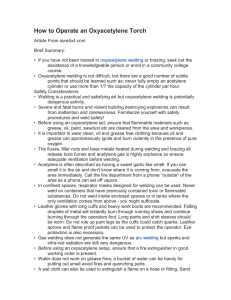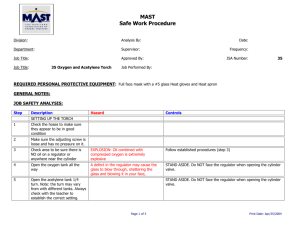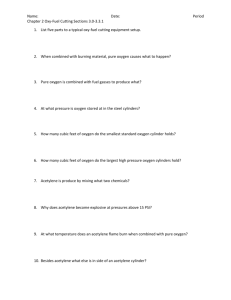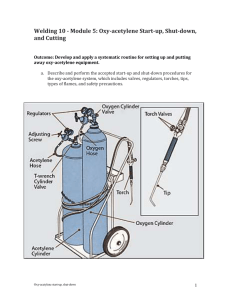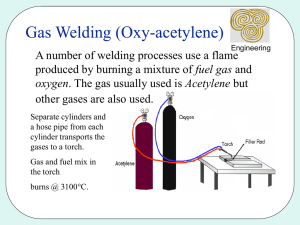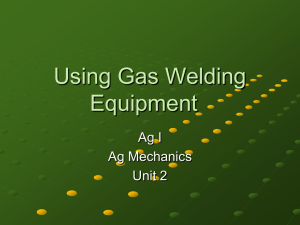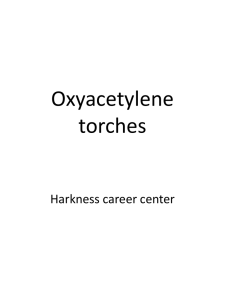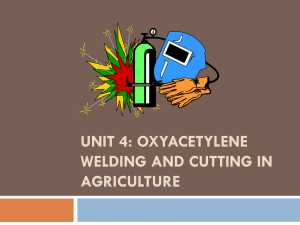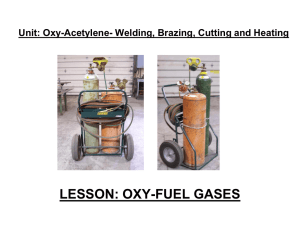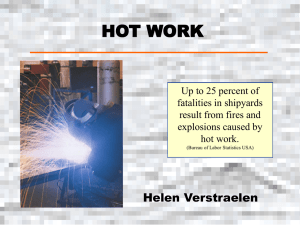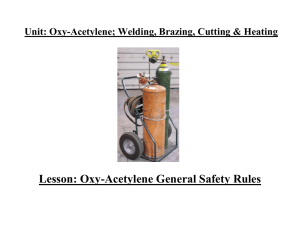Terms and Definitions
advertisement
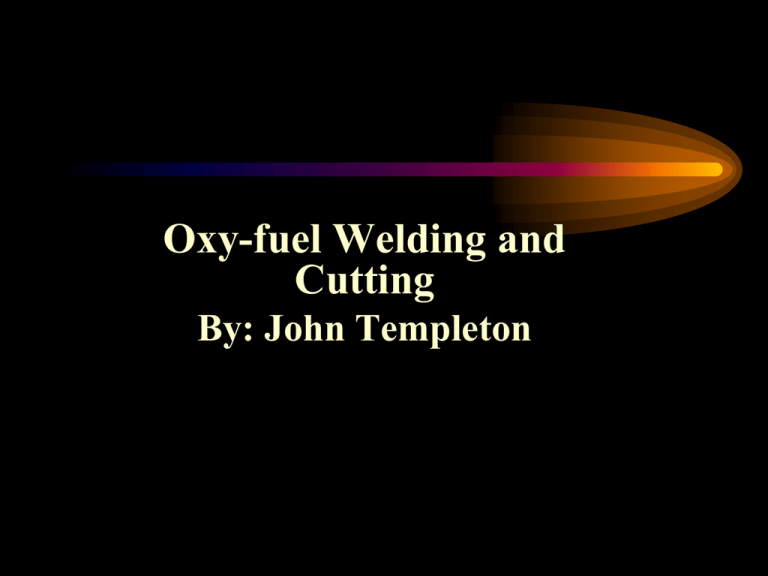
Oxy-fuel Welding and Cutting By: John Templeton Objectives • Understand facts about oxygen and acetylene • Explain functions of oxyacetylene heat • List the procedures for assembly of the oxyacetylene rig • Identify oxyacetylene equipment Objectives • Discuss safety precautions for oxyacetylene process • Describe the procedures for turning on/off the oxyacetylene rig Terms and Definitions • Penetration: Distance from the original surface of the base metal to that depth at which fusion stops. Good or Bad Penetration? Terms and Definitions • Backfire: A short pop of the torch flame followed by extinguishing of the flame or continued burning of the gases. • Flashback: when the torch flame moves into or beyond the mixing chamber. Terms and Definitions • Tack Weld: A short weld used to hold work pieces together • Preheating: Heating prior to a welding or cutting operation Benefits of Learning OxyAcetylene welding and cutting • Teaches methods used in forming and controlling a weld puddle • Teaches methods of using welding equipment and techniques that are useful in other welding processes Benefits of Learning OxyAcetylene welding and cutting • Provides practice leading to good hand-eye coordination • FUN Equipment required • Oxygen cylinder - filled with 2200 psi of pure compressed oxygen • Acetylene cylinder – filled with 250 psi of compressed acetylene • Pressure regulators- regulate the gas and oxygen pressure Equipment required • Two hoses encased together – green hose = oxygen – red hose = acetylene • Welding torch with tips • Welding goggles and safety glasses – shade 4-6 for oxy-fuel welding and cutting –Z87 safety glasses Equipment required • Striker- used to light initial flame • Check valves- to prevent flashback Safety Rules for OxyAcetylene Workplace • Keep work area free of grease, oil, and flammable materials • Cool or quench hot metal and extinguish all sparks before leaving Safety Rules for OxyAcetylene Workplace • Don’t leave torches, tips or hot metal where someone will pick them up • Never carry matches or lighters into any work area Personal Protective Equipment (PPE) • Shirts –Keep collar and sleeves buttoned to keep out sparks and remove pockets or tape them shut PPE • Pants –no cuffs or tears and come over shoe tops PPE • Shoes –leather, cover entire foot • Gloves –Leather, never use to pick up metal (must not have holes in the finger tips) PPE • Safety Glasses –worn under helmets and goggles (Z87) PPE • Wear safety glasses at all times • Wear welding goggles or a face shield with a lens no. 4-6 – when in doubt, start with a dark lens and then switch to a lighter one. Pressure Regulating Valves • Each regulator has two gauges mounted on a single manifold, one indicates cylinder pressure and the other indicates working pressure for the torch Hose Gauge Cylinder Gauge Pressure Regulating Valves • Each regulator has an adjusting screw so pressure to the torch can be quickly controlled by turning the screw rightytighty increases pressure, left-loosey decreases pressure Welding hoses • Color –Acetylenered, –Oxygengreen Welding hoses • Connecting threads – acetylene connectors have a V-groove and left handed threads and oxygen connectors have plain surfaces and right handed threads Parts of a welding torch • Torch body is the part of the torch that is held like a pencil, it contains two needle valves to control flow of gas • Welding head contains mixer, mixing throat, and the welding tip Basic Safety Rules • 1. Before you start make sure personal safety is followed and PPE is worn • 2. Make sure you have had instruction • 3. Release adjusting screw on regulators before opening valves Basic Safety Rules • 4. Stand on the opposite side of the regulator when opening a valve • 5. Open cylinder valve slowly, oxygen first and then acetylene just a quarter of a turn Basic Safety Rules • 6. Do not use or compress acetylene at pressure higher than 15 psi or oxygen at a pressure higher then 40 psi. • 7. Set working pressures as desired. • 8. Light acetylene first, shut it off first Basic Safety Rules • 9. Never use oil on regulators or any oxyfuel equipment • 10. Do not use oxygen as a substitute for compressed air • 11. Keep heat, flames and sparks away from combustibles. Basic Safety Rules • 12. Keep hoses out of sparks or spatter to prevent leaks • 13. To check for leaks use only soapy water Types of Flames • Oxidizing – Excess oxygen with no feather, makes hissing sound Types of Flames • Neutral – burns equal amounts of oxygen and acetylene and has a clear edged inner cone – most commonly used Types of Flames • Carburizing – Excess acetylene with an acetylene feather two to three times the length of the inner cone – Used some in hardsurfacing, adds carbon to metal Safely lighting a flame • Check the torch valves to make sure they are closed • Open the oxygen cylinder valve full open Safely lighting a flame • Open the acetylene cylinder 1/3 turn • Open the oxygen torch valve to get proper working pressure Safely lighting a flame • Close oxygen torch valve • Open the acetylene torch valve and set the proper working pressure Safely lighting a flame • Close the torch valve • Open the acetylene torch valve one and 1/2 of a turn Safely lighting a flame • Point the torch away • Crack acetylene valve • Strike a spark to ignite Safely lighting a flame • Open the valve until it jumps off the tip • Close the valve slightly to bring the flame back to the tip • Open the oxygen valve until a neutral flame is reached Guidelines for Flame adjustment • To get a neutral flame, always start with more acetylene, then increase oxygen until the acetylene feather disappears from the center cone • Excess oxygen causes molten metal to spark Guidelines for Flame adjustment • Make sure regulators are set for the pressures recommended for the tip size Shutting down the unit • Close the acetylene valve • Close the oxygen valve • Shut off the tanks • Open the acetylene to purge the line and then the oxygen Shutting down the unit • When both gauges read zero, close the valve • Open the oxygen valve Shutting down the unit • When both gauges read zero, close the valve • Release pressure by turning adjusting screw left (out) • Coil hoses and put tools away and properly store the unit Review • What are the parts of oxy-fuel equipment? • What are three safety precautions used when oxy-fuel welding? • How do you safely operate the oxyfuel equipment?
